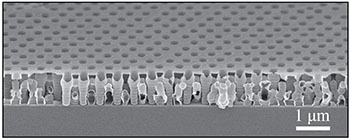
An array of tiny, highly ordered pores in a thin layer of aluminum oxide—fashioned through a two-step process on a polymer template that is subsequently “burned away”—results in mechanically strong dielectric films whose refractive index can be tuned to near that of air. [Image: Chih-Hao Chang]
A team of researchers from North Carolina State University (NCSU), USA, and the U.S. Air Force Research Laboratory has devised a method for creating 3-D, thin-shell nanomaterials with a refractive index near that of air—yet with low scattering levels and high mechanical stiffness that could make them suitable for incorporation into photonic and electronic devices (Adv. Funct. Mater., doi: 10.1002/adfm.201502854). The scientists believe that the material, incorporated as optical thin films, could find use in a variety of photonic structures, waveguides and other dielectric applications.
Designers of photonic devices are constantly on the lookout for materials that can bridge the refractive-index gap between air (n=1) and the lowest index found in naturally occurring solids (n=1.37, for MgF2). Strategies used in the past to push down n values have included introducing tiny air spaces into solids to move the index closer to that of air, and these approaches have indeed ratcheted down refractive indices to near unity (n=1.05, in some studies). But such materials have tended to have relatively low mechanical stability, high optical scattering or high absorption, all of which limit their usefulness in actual photonic applications.
To provide a different route to high-stiffness, low-index materials, the research team, led by NCSU professor Chih-Hao Chang, put together two different fabrication processes in a novel way. First, they used numerical modeling to design a polymer template including highly ordered pores, and fashioned the substrate from polymer nanospheres using a 3-D nanolithography process developed in the lab. Then, thin layers of zinc oxide or aluminum oxide were draped over the template surface using atomic layer deposition, which allowed subnanometer-scale control over the layer thickness.
Finally, the polymer substrate was “burned away” using a combination of heat treatment, dissolution and plasma cleaning. Left behind was a 3-D nanolattice coating consisting of periodic thin shells. Spectroscopic ellipsometry revealed that the Al2O3 material had a broadband refractive index of 1.025 at a shell thickness of 2.1 nm, and that the index could be tuned across the refractive-index gap by varying the shell thickness and the nanolattice material.
Further, spectrophotometer measurements showed the material to have scattering and transmission characteristics comparable to glass at a wide range of wavelengths. And “nanoindentation” experiments revealed a respectable mechanical stiffness (Young’s modulus) of roughly 7 GPa for the aluminum oxide shells at a thickness of 15 nm.
Chang believes that the specific steps in the process are “potentially scalable and compatible with existing chip manufacturing processes.” Looking ahead, the team will now focus on how the new low-n films can be integrated into actual optical and electronic devices.
